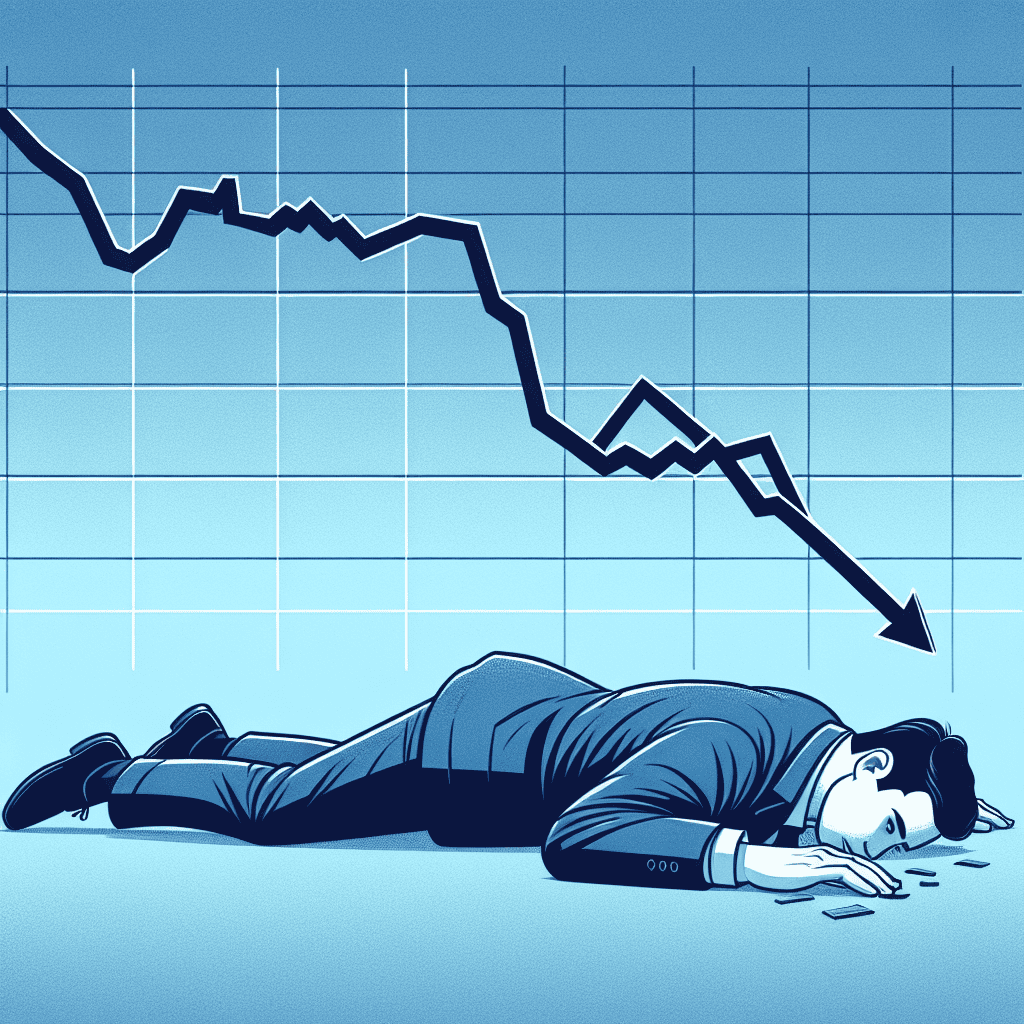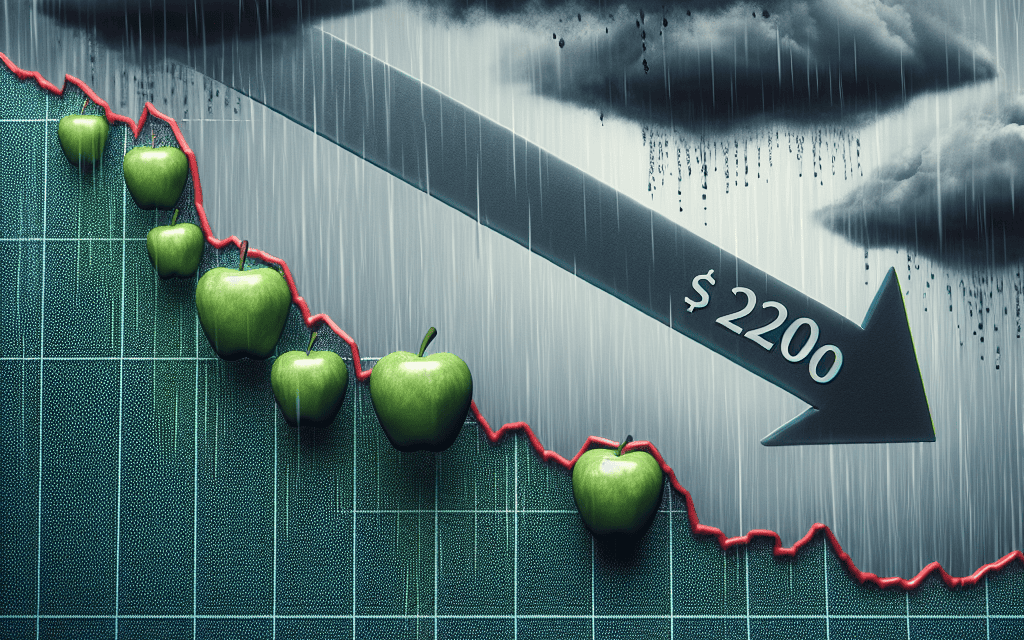“Apple’s Core Challenge: Shares Predicted to Fall Below $200 by Year-End”
Introduction
Title: Forecast: Apple Shares to Dip Below $200 by Year-End
Introduction: As the financial markets navigate through a year marked by economic uncertainty and shifting consumer dynamics, Apple Inc., a stalwart of technological innovation and market leadership, faces a potential downturn in its stock valuation. Analysts are increasingly forecasting that Apple’s shares, which have experienced significant volatility throughout the year, may dip below the $200 mark by the end of the fiscal year. This projection is driven by a confluence of factors, including supply chain disruptions, evolving competitive pressures, and macroeconomic challenges that are impacting consumer spending patterns. As investors brace for potential fluctuations, the focus intensifies on Apple’s strategic responses and market adaptability in the face of these headwinds.
Analysis Of Market Trends Impacting Apple Shares
As we approach the end of the year, investors and market analysts are closely monitoring the performance of Apple Inc., a company that has long been a bellwether for the technology sector. Recent forecasts suggest that Apple shares may dip below the $200 mark by year-end, a development that warrants a closer examination of the market trends influencing this potential decline. Several factors contribute to this forecast, each interwoven with broader economic and industry-specific dynamics.
To begin with, the global economic landscape is currently characterized by uncertainty, driven by factors such as inflationary pressures, fluctuating interest rates, and geopolitical tensions. These macroeconomic conditions have a direct impact on consumer spending, which is a critical driver of Apple’s revenue. As inflation continues to erode purchasing power, consumers may become more cautious with their discretionary spending, potentially leading to a slowdown in the sales of Apple’s premium products, including iPhones, iPads, and MacBooks. This anticipated reduction in consumer demand could exert downward pressure on Apple’s stock price.
Moreover, the technology sector as a whole is experiencing a period of heightened competition and rapid innovation. Companies are racing to develop the next generation of devices and services, and Apple is no exception. While Apple has historically been at the forefront of technological advancements, the pressure to continuously innovate can strain resources and impact profit margins. Additionally, competitors are increasingly closing the gap, offering high-quality alternatives at competitive prices. This intensifying competition may challenge Apple’s market share, further influencing investor sentiment and potentially contributing to a decline in its stock value.
In addition to these industry-specific challenges, Apple’s supply chain dynamics also play a crucial role in shaping its market performance. The company relies on a complex global network of suppliers and manufacturers, which has been disrupted by ongoing geopolitical tensions and trade uncertainties. These disruptions can lead to production delays and increased costs, which may ultimately affect Apple’s ability to meet market demand efficiently. As supply chain issues persist, they could weigh on Apple’s financial performance, thereby impacting its stock price.
Furthermore, regulatory scrutiny is another factor that could influence Apple’s market trajectory. Governments around the world are increasingly focusing on the practices of major technology companies, with Apple facing investigations related to antitrust concerns and data privacy issues. Such regulatory challenges can lead to legal battles and potential fines, which not only affect the company’s financial standing but also its reputation among consumers and investors alike. The uncertainty surrounding these regulatory matters may contribute to volatility in Apple’s stock price as the year progresses.
In conclusion, while Apple remains a dominant player in the technology sector, a confluence of macroeconomic pressures, competitive dynamics, supply chain challenges, and regulatory scrutiny suggests that its shares may experience a dip below the $200 mark by year-end. Investors should remain vigilant, considering both the risks and opportunities associated with Apple’s market position. As these trends continue to evolve, they will undoubtedly shape the company’s financial performance and influence its stock valuation in the months to come.
Factors Contributing To The Potential Decline In Apple Stock
Apple Inc., a titan in the technology industry, has long been a favorite among investors, consistently delivering robust financial performance and innovative products. However, recent analyses suggest that Apple shares may dip below the $200 mark by the end of the year. Several factors contribute to this potential decline, each interwoven with broader economic and industry-specific challenges.
To begin with, the global economic landscape is currently fraught with uncertainty. Inflationary pressures have persisted longer than anticipated, prompting central banks worldwide to adopt more aggressive monetary policies. The Federal Reserve, for instance, has been steadily increasing interest rates to combat inflation. Higher interest rates generally lead to increased borrowing costs for companies, potentially impacting their profitability. For Apple, which relies on a complex global supply chain, these increased costs could erode profit margins, thereby affecting investor sentiment and share prices.
Moreover, the ongoing geopolitical tensions, particularly between the United States and China, pose significant risks to Apple. China is not only a crucial market for Apple products but also a vital link in its supply chain. Any escalation in trade tensions or imposition of tariffs could disrupt Apple’s operations and sales in the region. Additionally, China’s economic slowdown, exacerbated by stringent COVID-19 lockdowns and regulatory crackdowns on technology firms, could further dampen consumer demand for Apple’s products.
In addition to these macroeconomic and geopolitical factors, Apple faces intensifying competition within the technology sector. Rivals such as Samsung, Google, and emerging Chinese brands are continually innovating, offering high-quality alternatives to Apple’s flagship products. This competitive pressure necessitates increased investment in research and development for Apple, which could strain financial resources and impact short-term profitability. Furthermore, the saturation of the smartphone market means that Apple must increasingly rely on its services segment for growth. While this segment has shown promise, it remains to be seen whether it can compensate for potential slowdowns in hardware sales.
Another critical factor is the potential for regulatory challenges. Governments around the world are scrutinizing large technology companies more closely, with concerns ranging from antitrust issues to data privacy. Apple has already faced legal battles over its App Store policies and could encounter further regulatory hurdles that might impact its business model. Such challenges could lead to increased legal costs and necessitate changes in operations, potentially affecting revenue streams.
Finally, investor expectations play a crucial role in stock performance. Apple has consistently set high benchmarks for itself, and any failure to meet these expectations could lead to a reevaluation of its stock value. Recent product launches, while successful, have not introduced groundbreaking innovations that significantly differentiate them from previous models. This perceived lack of innovation could lead to investor skepticism about Apple’s ability to maintain its growth trajectory.
In conclusion, while Apple remains a formidable player in the technology sector, a confluence of economic, geopolitical, competitive, regulatory, and investor-related factors could contribute to a decline in its share price below $200 by year-end. Investors should closely monitor these developments, as they will likely play a pivotal role in shaping Apple’s financial performance and stock market valuation in the coming months.
Investor Sentiment And Its Role In Apple’s Stock Performance
Investor sentiment plays a crucial role in the performance of Apple’s stock, influencing its valuation and market dynamics. As we approach the end of the year, there is growing speculation that Apple shares may dip below the $200 mark. This potential decline can be attributed to a confluence of factors, including market sentiment, economic conditions, and company-specific developments. Understanding the interplay of these elements is essential for investors seeking to navigate the complexities of the stock market.
To begin with, investor sentiment is often shaped by broader economic indicators and market trends. In recent months, concerns about inflation, interest rate hikes, and global economic slowdown have created a cautious atmosphere among investors. These macroeconomic factors have led to increased volatility in the stock market, prompting investors to reassess their portfolios and adopt a more conservative approach. Consequently, even well-established companies like Apple are not immune to the ripple effects of such market sentiment.
Moreover, Apple’s stock performance is also influenced by its own business operations and strategic decisions. While the company has consistently demonstrated strong financial results, there are emerging challenges that could impact its future growth prospects. For instance, supply chain disruptions and geopolitical tensions have raised concerns about Apple’s ability to maintain its production efficiency and meet consumer demand. Additionally, the competitive landscape in the technology sector is intensifying, with rivals continuously innovating and capturing market share. These factors contribute to a more cautious outlook among investors, potentially leading to a dip in Apple’s stock price.
Furthermore, the role of investor sentiment is amplified by the psychological aspects of market behavior. Investors often react to news and events based on perceptions and emotions, which can lead to overreactions and exaggerated price movements. In the case of Apple, any negative news or forecasts, whether related to its financial performance or external factors, can trigger a wave of selling pressure. This phenomenon is particularly evident in the technology sector, where stocks are often subject to rapid fluctuations driven by sentiment rather than fundamentals.
In addition to these considerations, it is important to recognize the influence of institutional investors and market analysts on Apple’s stock performance. These entities play a significant role in shaping market sentiment through their investment decisions and research reports. A downgrade in Apple’s stock rating or a reduction in price targets by major analysts can have a profound impact on investor confidence, leading to a potential decline in the stock price. As such, the interplay between institutional sentiment and individual investor behavior is a critical factor in determining the trajectory of Apple’s shares.
In conclusion, while Apple remains a dominant player in the technology sector, the potential for its shares to dip below $200 by year-end is a reflection of the complex interplay between investor sentiment, economic conditions, and company-specific factors. As investors navigate this landscape, it is essential to consider both the macroeconomic environment and the nuances of Apple’s business operations. By understanding the multifaceted nature of investor sentiment, market participants can make more informed decisions and better anticipate potential shifts in Apple’s stock performance.
Historical Comparisons: Apple’s Stock Fluctuations Over The Years

Apple Inc., a titan in the technology industry, has long been a focal point for investors and analysts alike, with its stock performance often serving as a barometer for the broader tech sector. Historically, Apple’s stock has experienced significant fluctuations, reflecting both the company’s internal developments and broader market trends. As we approach the end of the year, there is growing speculation that Apple shares may dip below the $200 mark, a prediction that invites a closer examination of the historical patterns that have characterized Apple’s stock movements over the years.
To understand the potential for a dip in Apple’s stock price, it is essential to consider the historical context. Apple’s journey in the stock market has been marked by periods of rapid growth, driven by innovative product launches and strategic business decisions. For instance, the introduction of the iPhone in 2007 was a pivotal moment that propelled Apple’s stock to new heights, as the device revolutionized the smartphone industry and solidified Apple’s position as a market leader. Similarly, the launch of the iPad in 2010 and the Apple Watch in 2015 further contributed to upward trends in the company’s stock price, as these products opened new revenue streams and expanded Apple’s ecosystem.
However, Apple’s stock has not been immune to downturns. Economic recessions, shifts in consumer preferences, and increased competition have all contributed to periods of decline. The global financial crisis of 2008, for example, saw Apple’s stock price fall significantly, as investors reacted to broader economic uncertainties. More recently, the COVID-19 pandemic initially led to a dip in Apple’s stock, as supply chain disruptions and changing consumer behaviors created challenges for the company. Despite these setbacks, Apple has consistently demonstrated resilience, often rebounding stronger than before.
As we consider the current forecast predicting a dip below $200, it is important to analyze the factors that may contribute to this potential decline. One key consideration is the broader economic environment. Rising interest rates and inflationary pressures have created a challenging landscape for tech stocks, as investors reassess valuations and growth prospects. Additionally, geopolitical tensions and regulatory scrutiny, particularly in key markets such as China and the European Union, have introduced new uncertainties that could impact Apple’s performance.
Moreover, Apple’s recent product announcements and strategic initiatives will play a crucial role in shaping investor sentiment. While the company continues to innovate, with recent launches such as the iPhone 15 and advancements in augmented reality, the competitive landscape is intensifying. Rivals are rapidly advancing their technologies, and consumer preferences are evolving, necessitating continuous adaptation from Apple to maintain its market position.
In conclusion, while the forecast of Apple shares dipping below $200 by year-end may seem concerning, it is essential to view this prediction within the broader historical context of Apple’s stock fluctuations. The company has weathered numerous challenges in the past, demonstrating an ability to adapt and thrive in a dynamic market environment. As investors and analysts closely monitor the factors influencing Apple’s stock, the company’s historical resilience offers a measure of reassurance. Nevertheless, the coming months will be critical in determining whether Apple can once again defy expectations and maintain its status as a leading force in the technology sector.
Expert Opinions On Apple’s Year-End Stock Forecast
As the year draws to a close, investors and market analysts are closely monitoring the performance of Apple Inc., a company that has long been a bellwether for the technology sector. Recently, a growing consensus among financial experts suggests that Apple shares may dip below the $200 mark by year-end. This forecast, while surprising to some, is grounded in a confluence of factors that are shaping the current market environment.
To begin with, the broader economic landscape is exerting pressure on technology stocks, including Apple. Rising interest rates, implemented by central banks to combat inflation, have increased the cost of borrowing. This, in turn, has led to a tightening of consumer spending, which is particularly impactful for companies like Apple that rely heavily on consumer purchases of high-end products. As consumers become more cautious with their spending, the demand for premium devices such as iPhones and MacBooks may experience a slowdown, thereby affecting Apple’s revenue projections.
Moreover, supply chain disruptions continue to pose significant challenges. Although Apple has demonstrated resilience in navigating these issues, the persistent global semiconductor shortage has constrained production capabilities. This bottleneck not only affects the availability of Apple’s products but also increases production costs, which could potentially squeeze profit margins. Consequently, investors are wary of how these operational hurdles might impact Apple’s financial performance in the coming months.
In addition to these macroeconomic and operational factors, competitive pressures are intensifying. Rivals in the technology sector are aggressively innovating and expanding their market share, particularly in emerging markets where growth potential is substantial. Companies such as Samsung and Xiaomi are offering competitive alternatives to Apple’s flagship products, often at more accessible price points. This increased competition could erode Apple’s market dominance, especially if the company is unable to differentiate its offerings through groundbreaking innovations or unique value propositions.
Furthermore, regulatory scrutiny is another element that cannot be overlooked. Apple, like many other tech giants, is under the microscope of regulators worldwide. Antitrust investigations and potential legislative changes aimed at curbing the power of large technology firms could impose new constraints on Apple’s business operations. These regulatory challenges add an additional layer of uncertainty for investors, who are already navigating a complex and volatile market environment.
Despite these challenges, it is important to acknowledge that Apple remains a formidable player in the technology industry. The company’s strong brand loyalty, robust ecosystem, and history of innovation provide a solid foundation for long-term growth. However, in the short term, the convergence of economic pressures, supply chain issues, competitive dynamics, and regulatory concerns may weigh heavily on its stock performance.
In conclusion, while the forecast of Apple shares dipping below $200 by year-end may seem pessimistic, it reflects a realistic assessment of the current market conditions. Investors should remain vigilant and consider these factors when making investment decisions. As always, the stock market is subject to rapid changes, and Apple’s ability to adapt to these challenges will be crucial in determining its trajectory in the months ahead.
The Impact Of Global Economic Conditions On Apple Shares
As the global economic landscape continues to evolve, investors are closely monitoring the potential impact on major corporations, with Apple Inc. being a focal point of interest. The tech giant, renowned for its innovative products and robust market presence, is not immune to the fluctuations of the global economy. Analysts are now forecasting that Apple shares may dip below the $200 mark by the end of the year, a prediction that warrants a closer examination of the underlying economic conditions influencing this outlook.
To begin with, the global economic environment is currently characterized by a series of challenges that are exerting pressure on financial markets. Inflation rates remain persistently high in many regions, prompting central banks to adopt tighter monetary policies. The Federal Reserve, for instance, has been steadily increasing interest rates in an effort to curb inflationary pressures. This monetary tightening, while necessary to stabilize prices, has the side effect of increasing borrowing costs for businesses and consumers alike. Consequently, consumer spending, a critical driver of Apple’s revenue, may experience a slowdown as individuals prioritize essential expenditures over discretionary purchases such as the latest iPhone or MacBook.
Moreover, the ongoing geopolitical tensions, particularly in Eastern Europe and Asia, have further complicated the economic outlook. These tensions have disrupted global supply chains, leading to increased production costs and delays in product availability. For a company like Apple, which relies heavily on a complex network of suppliers and manufacturers across the globe, these disruptions can translate into higher operational costs and potential revenue losses. The semiconductor shortage, a lingering issue from the pandemic era, continues to affect the tech industry, including Apple, by limiting the availability of critical components needed for its products.
In addition to these external factors, Apple’s own strategic decisions may also play a role in the anticipated dip in its share price. The company has been investing heavily in research and development to maintain its competitive edge, particularly in areas such as augmented reality and autonomous vehicles. While these investments are crucial for long-term growth, they may not yield immediate financial returns, potentially impacting short-term profitability and investor sentiment. Furthermore, Apple’s recent foray into the financial services sector, with products like the Apple Card and Apple Pay, introduces new regulatory challenges and competitive pressures that could affect its financial performance.
Transitioning to the broader market context, it is important to note that technology stocks, in general, have been experiencing heightened volatility. The tech sector, which enjoyed a significant boom during the pandemic as digital transformation accelerated, is now facing a period of recalibration. Investors are becoming more discerning, focusing on companies with strong fundamentals and sustainable growth prospects. In this environment, even a company as formidable as Apple is subject to scrutiny, and any perceived weaknesses or uncertainties can lead to fluctuations in its stock price.
In conclusion, while Apple remains a dominant player in the technology sector with a loyal customer base and a strong brand, the convergence of global economic conditions, supply chain challenges, strategic investments, and market dynamics suggests that its shares may indeed dip below $200 by year-end. Investors and stakeholders will need to navigate these complexities with a keen understanding of both macroeconomic trends and company-specific factors to make informed decisions. As the year progresses, the interplay between these elements will continue to shape the trajectory of Apple’s stock performance.
Strategies For Investors In Anticipation Of Apple’s Stock Dip
As the year draws to a close, investors are closely monitoring the performance of Apple Inc., a stalwart in the technology sector. Recent analyses suggest that Apple shares may dip below the $200 mark by year-end, prompting investors to reassess their strategies. Understanding the factors contributing to this potential decline is crucial for making informed decisions. Several elements, including market trends, economic conditions, and company-specific developments, are influencing this forecast.
Firstly, the broader market environment plays a significant role in shaping stock performance. The technology sector, in particular, has experienced heightened volatility due to global economic uncertainties and fluctuating consumer demand. Inflationary pressures and interest rate hikes have also contributed to a cautious investor sentiment, leading to a reevaluation of tech stocks. In this context, Apple, despite its robust fundamentals, is not immune to these macroeconomic forces. Consequently, investors are advised to remain vigilant and consider diversifying their portfolios to mitigate potential risks.
Moreover, Apple’s recent earnings reports have shown mixed results, with some areas of concern that could impact its stock price. While the company continues to demonstrate strong revenue growth, driven by its flagship products and services, there are signs of slowing momentum in certain segments. For instance, iPhone sales, a major revenue driver, have faced challenges due to supply chain disruptions and increased competition. Additionally, Apple’s expansion into new markets and product categories, such as augmented reality and electric vehicles, requires substantial investment, which may affect short-term profitability. Investors should closely monitor these developments and assess their implications for Apple’s long-term growth prospects.
In anticipation of a potential dip in Apple’s stock price, investors might consider several strategic approaches. One option is to adopt a defensive stance by reallocating assets into more stable sectors or companies with less exposure to market volatility. This strategy can help preserve capital and reduce the impact of a downturn in Apple’s shares. Alternatively, investors with a higher risk tolerance may view a dip in Apple’s stock as a buying opportunity. Historically, Apple has demonstrated resilience and an ability to rebound from temporary setbacks, making it an attractive option for long-term growth. By purchasing shares at a lower price, investors can potentially benefit from future appreciation as the company continues to innovate and expand its market presence.
Furthermore, options trading presents another avenue for investors to navigate potential fluctuations in Apple’s stock price. By utilizing strategies such as covered calls or protective puts, investors can hedge against downside risk while maintaining exposure to potential upside gains. These strategies require a thorough understanding of options markets and should be approached with caution, particularly for those unfamiliar with derivatives trading.
In conclusion, the forecasted dip in Apple’s stock price below $200 by year-end necessitates a proactive approach from investors. By staying informed about market trends, company performance, and strategic options, investors can make well-informed decisions that align with their financial goals and risk tolerance. Whether opting for diversification, capitalizing on buying opportunities, or exploring options trading, a thoughtful strategy can help navigate the challenges and opportunities presented by fluctuations in Apple’s stock price. As always, consulting with financial advisors and conducting thorough research is advisable to ensure that investment decisions are grounded in sound analysis and align with individual investment objectives.
Q&A
1. **Question:** What is the current forecast for Apple shares by year-end?
– **Answer:** Apple shares are forecasted to dip below $200 by year-end.
2. **Question:** What factors are contributing to the expected dip in Apple shares?
– **Answer:** Contributing factors may include market volatility, economic conditions, supply chain issues, or changes in consumer demand.
3. **Question:** How does the forecasted dip compare to Apple’s current share price?
– **Answer:** The forecasted dip suggests a decrease from the current share price, which is above $200.
4. **Question:** Are there any specific events or announcements that might influence Apple’s share price?
– **Answer:** Potential influences could include quarterly earnings reports, product launches, or changes in company strategy.
5. **Question:** What impact might this forecast have on investors?
– **Answer:** Investors might reconsider their positions, potentially selling shares or adjusting their portfolios in anticipation of the dip.
6. **Question:** How reliable are these forecasts for Apple’s share price?
– **Answer:** Forecasts are based on analysis and predictions, which can be uncertain and subject to change due to unforeseen factors.
7. **Question:** What strategies might investors use in response to this forecast?
– **Answer:** Investors might use strategies such as hedging, diversifying their investments, or buying on dips to manage risk.
Conclusion
The forecast suggesting that Apple shares may dip below $200 by year-end could be influenced by several factors, including potential market volatility, changes in consumer demand, or broader economic conditions. Analysts might be considering Apple’s recent financial performance, competitive pressures, or macroeconomic indicators such as interest rates and inflation. Additionally, any shifts in technology trends or supply chain disruptions could impact investor sentiment. However, it’s important to note that stock market predictions are inherently uncertain, and various unforeseen factors could alter this forecast. Investors should consider a range of analyses and remain cautious, as stock prices can be highly unpredictable.





